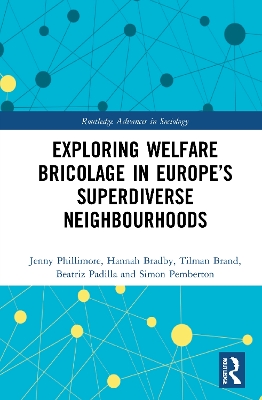Routledge Advances in Sociology
2 total works
Welfare Provision in an Era of Superdiversity
by Jenny Phillimore and Lisa Goodson
The past 20–30 years have seen enormous changes in the way we live as societies and cultures across the world have become integrated through communication, transportation, and trade. Globalisation has accelerated the speed and scale of migration, brought changes to migration patterns, and led to the development of the phenomena of new migration. Little is known about the experiences of new migrants trying to access welfare services in what has become acknowledged as a new era of migration: the era of super-diversity.
This book will be the first of its kind to focus on the current position and future implications of super-diversity and social welfare. It will look in detail at the impact of super-diversity for the delivery of social welfare across a range of social policy areas and provide an insight into the lives of migrant communities. By examining the exiting literature and empirical data the book will not only outline the current thinking and position on super-diversity but will also explore the possible trajectory of welfare systems and provide possible solutions by outlining mechanisms for mitigating the challenges facing migrants and providers operating in an era of super-diversity.
There are no competing books that cover super-diversity and welfare provision. It will therefore appeal to a number of different markets interested in the issues and challenges of super-diversity, including undergraduate and postgraduate students, academics interested in social policy-related research, policy makers and practitioners. The book is written in a student and lecturer friendly style, making it a useful teaching and research resource.
Exploring Welfare Bricolage in Europe’s Superdiverse Neighbourhoods
by Jenny Phillimore, Hannah Bradby, Tilman Brand, Beatriz Padilla, and Simon Pemberton
Migration-driven diversity means European cities are becoming increasingly superdiverse. Some European neighbourhoods have become places where newcomers arrive from across the world, speaking many different languages, from a range of socio-economic backgrounds and with diverse religious beliefs and practices, while living alongside long-established migrant and white European populations. This book focuses on what this increasing population diversity means for how people and local health and welfare service providers seek to address everyday health concerns – from minor and chronic conditions to acute and urgent problems.
Using an innovative mixed-method approach crossing multiple disciplines and drawing together rich qualitative and robust quantitative data, this book offers unique insight into the complex and intricate actions, which often vary over space and time, implemented by both residents and care providers from eight superdiverse localities in four European countries, each with different health and welfare traditions. The book introduces the concept of welfare bricolage, using it as a mechanism to explore the structures and rationales underpinning need and actions, and how resources are connected across welfare regimes and borders and within locales. The book illustrates how, in the face of increasingly marketised, cash-strapped, restrictive and institutionally racist welfare states and healthcare regimes, individuals and service providers strive to address need.
By focusing on welfare regimes, migration histories, everyday actions and resources within neighbourhoods, Exploring Welfare Bricolage in Europe’s Superdiverse Neighbourhoods offers a unique insight into what people and providers actually do when faced with health concerns. The book highlights the role of structure and agency and moves beyond conventional approaches that focus on specific groups or sectors to research health and welfare by looking at whole populations and entire welfare ecosystems. The book’s theoretical, methodological and empirical contributions will be of use to scholars, practitioners and policymakers interested in welfare, healthcare, diversity and migration.

